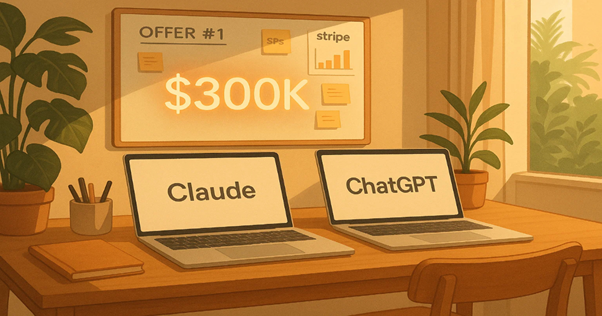Most people still think artificial intelligence is something only developers or analysts can monetize. But some of the highest-earning solo operators I’ve met in 2025 don’t write code at all. They write prompts. And their tools? Just ChatGPT, Claude AI – and occasionally Gemini or Perplexity.
Prompt engineering has quietly become one of the most profitable skills online. Unlike no-code automation or paid media, it doesn’t require a budget, team, or even an audience. Just precision, repeatable thinking, and a few hours of practice.
This isn’t about generic hacks. This is exactly how full-time prompt engineers are turning ChatBot tools like ChatGPT and Claude into six-figure engines of income – in industries from SaaS and B2B to coaching and solopreneur consulting.
The $300K Prompt Engineering Breakdown
A $300K/year income is $25K/month. For most prompt engineers hitting those numbers, income splits look like this:
| Revenue Stream | Avg. Monthly Revenue | Notes |
| Client Prompt Systems | $8K – $12K | Building and licensing prompt stacks |
| AI Course Sales | $4K – $10K | Teaching prompt engineering via Notion/Gumroad |
| Internal GPT Workflows | $3K – $8K | Automation for ops, content, research |
| Productized Services | $5K – $15K | Cold outreach, funnel build, market research prompts |
And most use nothing more than Claude Opus and GPT-4 to run everything.
What makes this work isn’t just knowing how to prompt – it’s building systems that perform predictably across AI models.
How ChatGPT and Claude Split Roles for Real Prompt Engineers
Most prompt engineers treat ChatGPT and Claude like specialized teammates.
Claude Opus is preferred for:
- Long-form structured writing
- Empathetic, human-sounding copy
- Step-by-step analysis and logical workflows
ChatGPT (GPT-4) is ideal for:
- Formatting, structure, and summarization
- Ad frameworks, headline formulas
- Translating insights into punchy execution
High-earning prompt engineers run every major task through both models and evaluate based on:
- Fidelity of structure
- Context retention
- Use-case fit
You don’t just ask “which is better?” – you test both for the job.
Why I Run Every Prompt Stack Through Chatronix
Here’s where the game changed: trying to manage Claude, GPT-4, Gemini, and Perplexity across five tabs was destroying my focus. Every model has a different login, formatting, quirks. Claude adds soft tone. GPT gives you bold structure. But managing them? Brutal.
So I started running every workflow inside Top AI workspace for prompt engineering – the one workspace where all top models live together. No switching tabs, no reformatting. Just one interface. Six AI models. Side-by-side responses. Turbo mode. And 10 free prompts if you’re testing the waters.
I use it to:
- Compare Claude and GPT-4 instantly
- Reuse and tweak my best-performing workflows
- Simulate “client tone” before delivery
The real unlock? Running one prompt, six models. Then picking the best result.
How to Become a Prompt Engineer in 3 Steps
You don’t need to enroll in a $3,000 bootcamp or study for weeks.
Most of the $300K earners I’ve interviewed did one thing right early: they specialized their prompting around business outcomes.
Here’s how they do it.
1. Master One Outcome (Not a Model)
Pick one of these:
- Turn strangers into leads (outreach prompt stacks)
- Turn ideas into offers (product building stacks)
- Turn documents into insights (summarization and analysis)
- Turn client chaos into SOPs (ops automation prompts)
Then build 3-5 workflows that solve that repeatedly.
2. Write Like a Builder
Prompt engineers don’t ask AI for magic. They feed it structured ingredients.
Example:
“Analyze the following product idea and generate a 4-step funnel framework. Include user objections, offer positioning, and tone suggestions. Format the output with headings and bullets. Model tone after the given brand style guide.”
Good prompts = high leverage.
3. Build a Library of Proven Variants
Most prompt engineers have 3 versions of every workflow:
- A “safe” prompt for general use
- A “bold” prompt for aggressive copy
- A “debug” version that explains its reasoning
Then they test them in Chatronix, side-by-side, using:
- AI detection (does it sound human?)
- Conversion rates (for actual outreach)
- Client response time
What High-Earning Prompt Engineers Actually Sell
Here are the most common client-facing deliverables you can package right now:
- Outbound prompt packs for agencies and consultants
- Positioning frameworks for product teams
- AI assistant templates for course creators and SaaS founders
- Summarization workflows for analysts and researchers
You’re not just selling a prompt. You’re selling clarity – without hiring a strategist.
Bonus: My Top 3 Income-Generating Prompts (You Can Use)
Here are 3 prompts I used this year across Claude and GPT-4 that each helped generate real revenue (through licensing or delivery).
1. Cold Email Generator (High-Trust Niche)
“Create a cold email outreach sequence targeting fractional CFOs. Each email should be 3 sentences max, include a specific trigger event, and build trust via testimonial format. Use a casual, smart tone. No selling in email 1.”
2. Offer Builder for Creators
“Turn the following skillset into a scalable productized offer. Include the following: service scope, pricing model, delivery framework, ideal audience, and how to test MVP in 7 days. Format for Notion.”
3. SOP Builder from Slack Threads
“Extract process steps from this Slack conversation. Identify roles, key decisions, blockers, and client-facing dependencies. Summarize in standard operating procedure format with timestamps and responsible team member tags.”
Each of these were tested across Claude and ChatGPT. Then finalized in Chatronix to find the strongest version.
<blockquote class=”twitter-tweet”><p lang=”en” dir=”ltr”>ChatGPT – Cheat Sheet <a href=”https://t.co/jjojwstZ78″>pic.twitter.com/jjojwstZ78</a></p>— Book Therapy (@Book_therapy223) <a href=”https://twitter.com/Book_therapy223/status/1943568439022424162?ref_src=twsrc%5Etfw”>July 11, 2025</a></blockquote> <script async src=”https://platform.twitter.com/widgets.js” charset=”utf-8″></script>
Final Word: You Don’t Need to Code – You Need to Think in Prompts
In 2025, prompt engineering is a form of business logic.
Founders don’t need more code – they need better thinking. Prompt engineers are the new operators. They sit between messy ideas and clean execution.
And they do it with the same models everyone else has access to.
What separates the $300K engineers from the weekend tinkerers? A system.
Start with one prompt. Build it into a workflow. Test it in Claude, GPT, Gemini. Save the winner. Reuse it.
And if you want to run all those tests – across all models – in one place? Try Chatronix.



